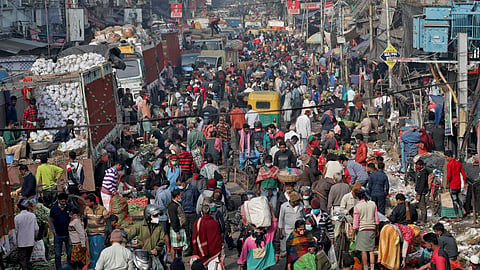

The United Nations Population Fund’ State of the World Population Report 2023 recently forecast that India is set to overtake China to become the world’s most populous country by the end of June. Our population is pegged to hit 142.86 cr against China’s 142.57 cr. This implies that India will have 29 lakh more citizens compared to its neighbour, making us the world’s most populous country. In recent years, India has been adding around 1.6-1.7 crore annually to the population, which might indicate us having already crept ahead of China or set to do so very soon.
The country was not expected to become the most populous until later this decade. However, a drop in China’s fertility rate has accelerated our growth. Among BRICS nations, India has the second highest total fertility rate (TFR) of 2 per woman, and is preceded by South Africa with a TFR of 2.3 per woman, and trailed by China with a TFR of 1.2. Our youth demographic is the largest in the world with 25.4 cr in the 15-24 age bracket, while 68% of the country’s population falls under the 15-64 age group, whereas just 7% of the population includes those over 65.
The numbers paint a rosy picture of youthfulness. But it might be premature to celebrate. Beijing shot off a sharp repartee upon the release of the UN population report. It asserted that while assessing a nation’s demographic dividend, the world must look at not just the size, but also the quality of its population. While size is a significant metric, what might be the key differentiator is the availability of talented resources.
The Chinese foreign ministry spokesman added that 900 mn of the 1.4 bn Chinese nationals are of working age, and on an average have received 10.9 years of education. New entrants to the workforce boast an average of 14 years of education, which is a sign that China’s demographic dividend is nowhere close to its end. The remarks have come on the back of global anxieties pertaining to the outsize effects that its shrinking population could have on the international economy.
The nation was once known as the factory of the world, with a massive working age population offering a steady supply of cheap labour, producing goods exported globally. A better educated workforce and a diminishing populace could exacerbate inflation in first world nations heavily dependent on Chinese goods.
Several nations have already begun shifting their manufacturing operations to lower paying nations like Vietnam and Mexico, and even India as well.
And it’s an opportunity that India must not squander away. A shortage of gainful employment in India has resulted in the farm sector contributing over 45% to the nation’s employed labour force, despite the sector’s GDP contribution being just 20%. Between 2014-22, as many as 220 mn people applied for government jobs which were landed by 7 lakh people — a minuscule 0.32%. CMIE surveys tell us that our labour force participation rate is a paltry 40% and the contribution of women is just about 10%, which is pitiable to put it mildly.
With close to 50% of the population below the age of 25, India has a massive potential to convert the potential demographic dividend into economic benefits through big ticket investments in health, education, quality jobs as well, as well as targetted interventions for women and girls. Let’s not forget, quantity cannot make up for quality.
Visit news.dtnext.in to explore our interactive epaper!
Download the DT Next app for more exciting features!
Click here for iOS
Click here for Android